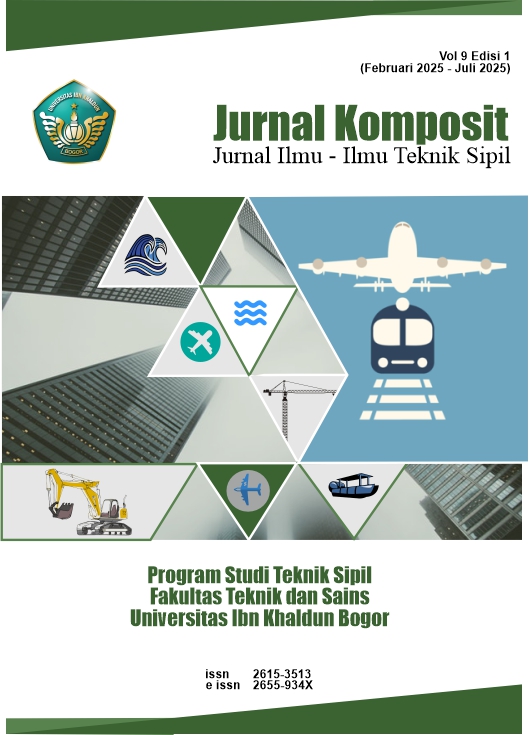Implementasi Building Information Modeling (BIM) 5D Pada Proyek Konstruksi (Studi Kasus Pada Proyek Pembangunan Resto Manggar)
DOI:
https://doi.org/10.32832/komposit.v9i1.17282Keywords:
BIM 5D, Autodesk Revit, Estimated CostAbstract
With the increasing development of the AEC (Architecture, Engineering and Construction) industry in the current era, there is a lot of software being developed for the needs of the construction industry which aims to minimize human error due to conventional data processing. This research aims to analyze the results of volume and cost comparisons using the 5D Building Information Modeling (BIM) concept with the consultant method on the Resto Manggar Balikpapan Timur construction project. By using Revit, the 2D image obtained from the consultant is modeled again in 3D form where the volume requirements for structural work become more detailed. We can see from the consultant's calculation that the weight is 11,0881.42 kg from the Autodesk Revit software, it is 10,382.58 kg and has a difference of 698.84 kg or 6 %, for the concrete volume results from the consultant of 132.30 m3, the Autodesk Revit software has a volume of 127.01 m3 and has a difference of 5.29 m3 or 4%. To calculate costs for structural work from the consultant, it is IDR. 193,025,200.89 from Autodesk Revit software has a cost of Rp. 181,502,892.27 which has a cost difference of Rp. 11,522,308.62 or 6%, for the calculation of concrete costs by the consultant of Rp. 203,773,342.67 from Autodesk Revit software amounting to Rp. 195,402,397.86 and has a difference in concrete costs of Rp. 8,370,944.81 or 4%. By using the 3D BIM concept supported by Revit software which is able to provide detailed material takeoff results thereby reducing wasted material and supporting the 5D BIM concept to support cost estimation calculations.
References
Eastman, et al. (2008). Concept of BIM. Di dalam skripsi: Janni Tjell (Ed). Building Information Modelling (BIM) In Design Detailing With Focus On Interior Wall
Systems, 2010. Denmark: 1-2. https://eng.unhas.ac.id/tepat/index.php/Jurnal_Tepat/article/view/82
Erfaliani, A. P., Pradika, J. D., Hendriyani, I., & Pratiwi, R. (2024). Analisis Waktu dan Biaya pada Proyek Pembangunan Pasar Induk Senaken Kabupaten Paser dengan Metode Time Cost Trade Off (TCTO) . Jurnal Komposit: Jurnal Ilmu-Ilmu Teknik Sipil, 8(2), 297–308. https://doi.org/10.32832/komposit.v8i2.15938
Farhana, A., & Abma, V. (2022). Implementasi Konsep BIM 5d pada Pekerjaan Struktur Proyek Gedung. Racic: Rab Construction Research, 7(2), 116-127. https://doi.org/10.36341/racic.v7i2.3004
Hasan, Iqbal. (2002). Metodologi Penelitian dan Aplikasinya. Jakarta: Ghalia Indonesia. https://inlislite.uin-suska.ac.id/opac/detail-opac?id=12854
Heryanto, S., & Subroto, G. (2020). Kajian Penerapan Builidng Information Modelling (Bim) Di Industri Jasa Konstruksi Indonesia. Architecture Innovation, 4(2), 193-212. DOI: https://doi.org/10.36766/aij.v4i2.157
Huzaini, S. (2021). Penerapan Konsep Building Information Modelling (BIM) 3d dalam Mendukung Pengestimasian Biaya Pekerjaan Struktur. Skripsi. Repository Universitas Islam Indonesia. https://dspace.uii.ac.id/handle/123456789/34227?show=full
Ibrahim, B. (2001). Rencana dan Estimate Real of Cost. Jakarta: Bumi Aksara. https://inlislite.uin-suska.ac.id/opac/detail-opac?id=5676
Kementerian PUPR. (2019). Peraturan Menteri Pekerjaan Umum dan Perumahan Rakyat Nomor 21 Tahun 2019 Tentang Sistem Manajemen Keselamatan Konstruksi
Kementerian PUPR. (2022). Permen PUPR No. 7 Tahun 2022 tentang Pelaksanaan Bantuan Pembangunan Perumahan Dan Penyediaan Rumah Khusus.
Khasanah, L., & Wirakusuma, I. (2022). Design Of Beam Based On BIM Method Using Autodesk Revit and Autodesk RSAP. Jurnal Extrapolasi, 19(2). DOI: https://doi.org/10.30996/ep.v19i02.7884
Laorent, D., Nugraha, P., & Budiman, J. (2019). Analisa Quantity Take-Off Dengan Menggunakan Autodesk Revit. Dimensi Utama Teknik Sipil, 6(1), 1–8. https://doi.org/10.9744/duts.6.1.1-8
Moleong, J Lexy. (2005). Metodologi Penelitian Kualitatif, Edisi Revisi. Bandung: PT Remaja Rosdakarya
Nadeem, A., Wong, A. K., & Wong, F. K. (2015). Bill of quantities with 3D views using building information modeling. Arabian Journal for Science and Engineering, 40, 2465-2477. DOI: https://doi.org/10.1007/s13369-015-1657-2
Pratiwi, R., Devi, S. M., Indriani, A. M., & Sari, H. M. (2022). Optimasi Waktu Dan Biaya Dengan Metode Time Cost Trade Off (TCTO) Pada Proyek Penambahan Bangunan Pasar Rakyat. Jurnal Ilmiah Teknik Sipil Transukma, 4(2), 93-105. DOI: https://doi.org/10.36277/transukma.v4i2.134
Putra, Z. Z. D., Danuarta, F., Pratiwi, R., & Hendriyani, I. (2024). Analisis Pekerjaan Beton Bertulang dengan Building Information Modelling (BIM) 5D pada Proyek Pembangunan Kantor dan Pos Jaga Depot Supply Point Pertamina Lubricants Tarakan. Jurnal Komposit: Jurnal Ilmu-Ilmu Teknik Sipil, 8(2), 271–278. https://doi.org/10.32832/komposit.v8i2.15893
Qodiron, L., Oktarina, D., & Fadilasari, D. (2023). Penerapan Sketchup dalam Perhitungan Rencana Anggaran Biaya sebagai Pendekatan BIM pada Pembangunan Rumah Tipe 45 . Jurnal Komposit: Jurnal Ilmu-Ilmu Teknik Sipil, 7(2), 173–181. https://doi.org/10.32832/komposit.v7i2.14253
Sugiyono. (2009). Metode Penelitian Kuantitatif, Kualitatif, dan R&D. Bandung: Alfabeta.
Santosa, B. (2009). Manajemen Proyek: Konsep & Implementasi. Yogyakarta: Graha Ilmu.
Fitriono, F., Haza, Z. F., & Shulhan, M. A. (2023). Analisis Perbandingan Rencana Anggaran Biaya (RAB) Metode Konvensional Dengan Metode Building Information Modeling (BIM) (Studi Kasus Gedung 3 Lantai Di Yogyakarta). Surya Beton: Jurnal Ilmu Teknik Sipil, 7(1), 13-24. https://jurnal.umpwr.ac.id/index.php/suryabeton/article/download/3031/1533
Downloads
Published
How to Cite
Issue
Section
License
Copyright (c) 2025 Jurnal Komposit: Jurnal Ilmu-ilmu Teknik Sipil

This work is licensed under a Creative Commons Attribution-NonCommercial-ShareAlike 4.0 International License.
Authors who publish with this journal agree to the following terms (Penulis yang mengajukan publikasi artikel telah menyetujui hal berikut):
- Through this publication, the author agree to submit the copyright of article writing to Jurnal Komposit: Jurnal Ilmu-ilmu Teknik Sipil. This copyright submission takes the form of, but is not limited to: reproduction of the article and parts therein, including photographic reproductions; distribution of articles through printed and electronic documents; and translation of articles(Bahwa melalui publikasi ini, hak cipta penulisan artikel diserahkan kepada Jurnal Komposit: Jurnal Ilmu-ilmu Teknik Sipil. Penyerahan hak cipta ini berupa, namun tidak terbatas pada: perbanyakan artikel dan bagian di dalamnya, termasuk reproduksi fotografi; penyebarluasan artikel melalui dokumen cetak dan elektronik; serta penterjemahan artikel).
- The authors agree to the terms of the Copyright Notice, according to Creative Commons Attribution-NonCommercial-ShareAlike 4.0 International License., which will apply to this article if and when it is published by Jurnal Komposit: Jurnal Ilmu-ilmu Teknik Sipil. (Para penulis setuju dengan ketentuan Pemberitahuan Hak Cipta, sesuai dengan Lisensi Internasional Creative Commons Attribution-NonCommercial-ShareAlike 4.0., yang akan berlaku untuk artikel ini jika dan ketika diterbitkan oleh Jurnal Komposit: Jurnal Ilmu-ilmu Teknik Sipil).

This work is licensed under a Creative Commons Attribution-NonCommercial-ShareAlike 4.0 International License.



.png)










